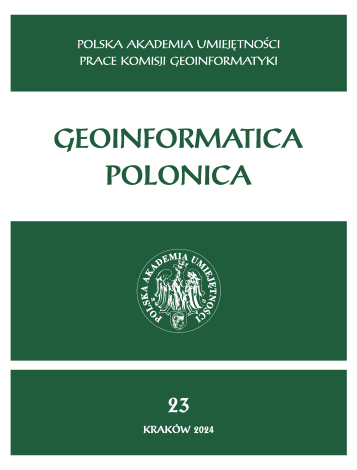GDDKIA xml service, road traffic incidents data: availability and quality research
GDDKIA xml service, road traffic incidents data: availability and quality research
Author(s): Natalia Dziuba, Stanisław SzombaraSubject(s): Human Geography, Applied Geography
Published by: Wydawnictwo Uniwersytetu Jagiellońskiego
Keywords: GIS; real-time data; traffic incidents; geoinformation
Summary/Abstract: With the rapid development of technology and the increasing amount of data being processed, smart cities use real-time information processing to optimise various processes, including navigation and traffic management. In this context, spatial data on traffic incidents plays a key role, enabling drivers to bypass congestion and navigate safely and efficiently through the city. This study focuses on assessing the quality and availability of spatial data on road obstructions provided by the General Directorate for National Roads and Motorways (pl.: Generalna Dyrekcja Dróg Krajowych i Autostrad, GDDKiA) in Poland. In order to analyse this data, a web application was developed to visualise the data on a map to identify problems related to the accuracy of locations and the lack of key information. During the study, it was found that many of the points that were supposed to represent the locations of road incidents were at a significant distance from the actual road axes, indicating errors in geolocalisation. To improve accuracy, additional algorithms were applied that automatically corrected the position of the points to match the nearest roads. Additionally, in cases where geographic coordinates were missing, a geocoding method based on OpenStreetMap data was used. The analysis showed that the data from the General Directorate for National Roads and Motorways is partly incomplete and problematic, which limits its usefulness in further spatial analyses. In addition, the irregular updating of the data at 10-minute intervals and the low number of reported incidents further affect their quality and usefulness. Furthermore, comparison of the visualisation results with the GDDKiA road information map revealed significant discrepancies in the location of obstructions, suggesting that data sources or processing methods may differ. The results suggest the need to improve the accuracy and completeness of the spatial data provided so that it can effectively support cartographic analyses and visualisations.
Journal: Geoinformatica Polonica
- Issue Year: 2024
- Issue No: 23
- Page Range: 91-99
- Page Count: 9
- Language: English

